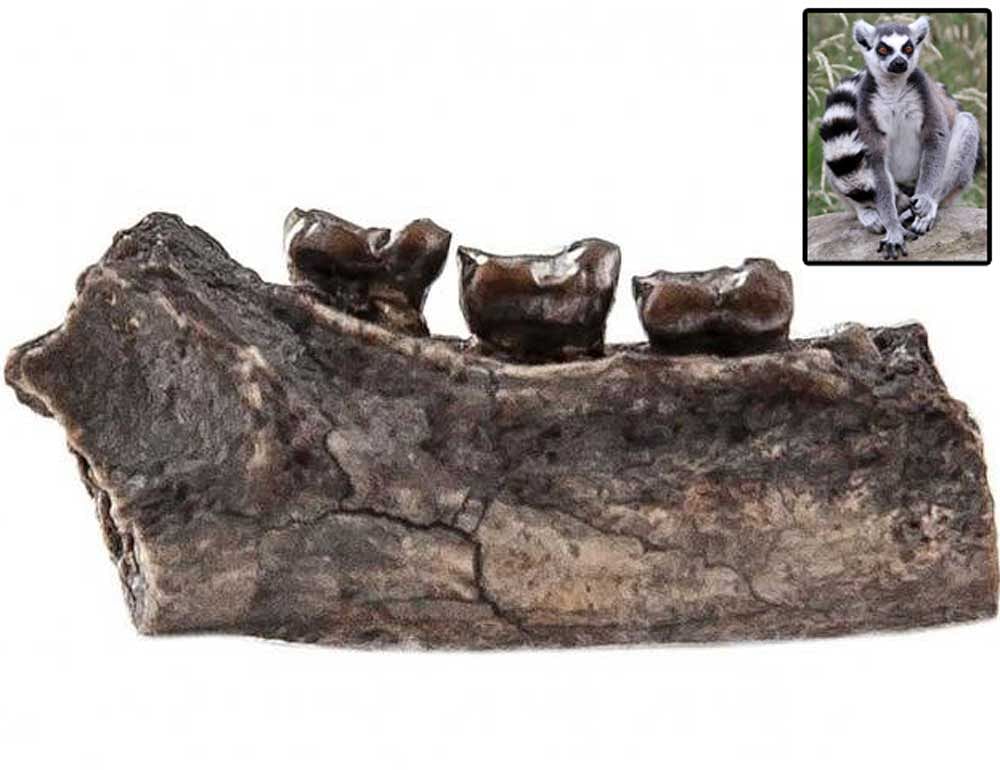
Lemurs are primates that look something like a cat crossed with a squirrel and a dog. These animals are unique to the island of Madagascar and are famous for their unusual and interesting behaviour like singing like a whale or dancing across the island like a ballet dancer.
Madagascar is over 5,000 km away from India, and therefore, it is hard to believe that an animal like lemur that is unique to this one island could have been, many moons ago, living in the Kashmir region of India. But that is exactly what has been discovered by fossil hunters after six years of tireless work, thus filling an incredible biogeographical gap never before documented.
The fossil discovered in the Ramnagar region of Jammu and Kashmir is an inch and a quarter partial jawbone of a primate. The scientists inferred that it belongs to a species that weighed less than five kg and lived between 11 million to 14 million years ago in this region. The experts further believe that this primate could be an ancestor of the present day lemur — primarily eating leaves, and the size of a house cat. In honour of the eminent Indian palaeontologist, Ashok Sahni, the newly discovered primate has been named Ramadapis sahnii. In palaeontology terms, these atypical primitive primate fossils from the region are collectively called Sivaladapids.
Favoured site
The lower Shivalik ranges of Ramnagar have long been a fossil hunter’s favoured site in India for digging out primate fossils. Till 2013, 46 mammalian species had been recorded from this area, which includes the famous first primate fossil discovery made by American bone collector Barnum Brown in 1924 when he found an important fossil jaw of an early great ape, which is a close relative of the orangutan. Ashok Sahni and an American colleague later in 1979 found first primate fossil belonging to a Sivalidapid here. Thus, the discoveries have revealed that India was once home to primitive orangutans and lemurs.
“Even though people have been collecting fossils at Ramnagar for almost 100 years, our study demonstrates that the areas still hold potential to produce new specimens and inform us about primate diversity and evolution in India approximately 11 to 14 million years ago,” says Christopher C Gilbert, lead author of the new study that appeared in the Journal of Human Evolution. Dr Biren Patel, a part of the team and associate professor of clinical cell and neurobiology Keck School of Medicine of USC, USA, says, “In the past, people were interested in searching for big things. A lot of the small fossils were not on their radar.” It is indeed this tiny discovery that fits like a piece of puzzle into the very path of evolution of humans as we too are primates, cousins of the great apes and related, even if distantly, to Ramadapis sahnii.
Evolution mysteries
“New primates are always a hot topic, and this one is the first of its kind from its area in Asia, which has significant consequences for understanding primate evolution in the Old World,” says Michael Habib, assistant professor of clinical cell and neurobiology at Keck School of Medicine of USC, USA. This new primate is a cousin of species found in North America, Europe and Africa millions of years ago. In fact, what surprised the team was that the Indian species might have been living in North India at a time when its relatives in other continents had already disappeared! While many anthropoid primates (early monkey relatives) went extinct in Asia around 34 million years ago, these primates survived until six million years ago until more modern monkeys and apes arrived from Africa.
What is of equal interest is the region where the discovery was made. The place today is a rocky terrain but discovery of the primate indicates that it was a tree dweller, and mostly ate leaves. This leads to the theory that Ramnagar, millions of years ago, could have been a forested region. Ashok thinks that this fossil belongs to a primate that lived at a peculiar time in history. It was when the land we know as India today was drifting away from Africa and Madagascar and was slowly moving towards the Asian plate. The fact that the species became extinct in other places but managed to survive here indicates that it had special conditions in India that allowed its survival.
Another significant lead this fossil provides is for geneticists who can now pinpoint more accurately on the time when two similar species diverged into separate groups in history. The experts say that just like the discovery of the orangutan-like species in the 1980s provided a time to when they might have drifted from Africa, this lemur-like species points to its separation and presence in Asia.
Old world monkeys and new world monkeys, lemurs and the great apes like bonobos, chimpanzees, and orangutans are all connected through a common evolution history with each other and with us humans. A small piece of relic found in a testing terrain like Ramnagar can thus have far-reaching consequences in changing our knowledge about our ancestors and binding us even more strongly to the animal world we sometimes treat as separate entities.